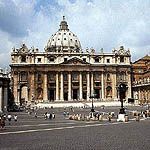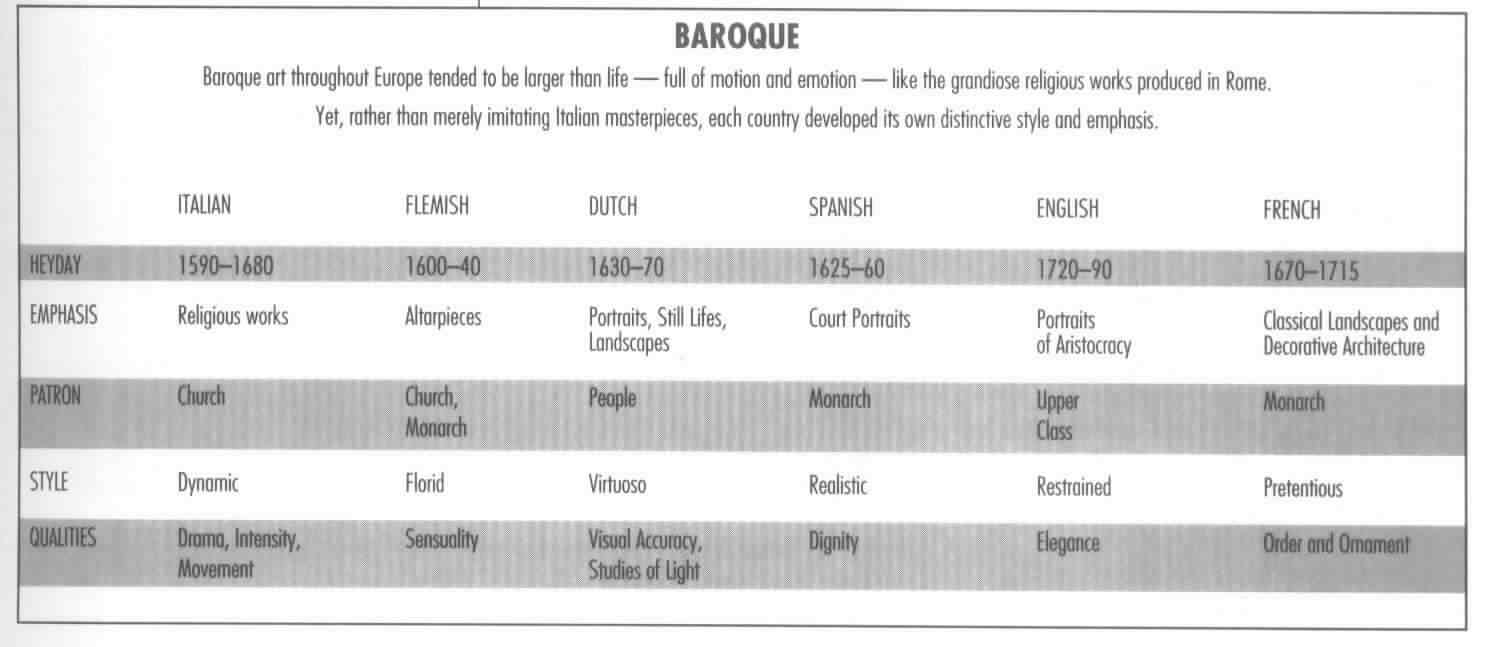6. Baroque Synopsis art 162 honors
ITALIAN BAROQUE ART
After a brief interlude of Mannerist distortion of the High Renaissance' Classical naturalism, artists of the Baroque period returned to the High Renaissance' vocabulary of idealism and realism, but with a new emphasis on passion and engagement with the existing world. Dynamic and expansive, Baroque art created a drama that involved the viewer as a participant, rather than in contemplating the static subject of the Classical moment. - DJB
• Italian Baroque 1575 - 1700
• Catholic Baroque 1600 - 1700
• Protestant Baroque 1600 - 1700
TERMS
Baroque - Portuguese term for irregularly-shaped
pearl, originally used pejoratively to describe post-High Renaissance/Mannerist
era
Idealism - the depiction of objects and figures
as "ideals" - the manner in which the aethestic values of the
era believes the ideal or perfect object or figure SHOULD be
Baldacchino - portable canopy to place over
Catholic altar; permanent covering over altar in St. Peters, Rome
Repussoir figure - large object in foreground of Baroque landscapes to
initiate sense of scale (i.e., large leafy tree, etc.)
Little Masters - term applied to painters of
Protestant Baroque who specialized in specific genres
Etching - method of producing prints wherein
acid is used to etch the plate after exposing surface of plate with linework
Camera obscura - forerunner of contemporary
camera, early device to reproduce an image using a pinhole inside an enclosed
box to project image on opposite wall of box
Classicism - artistic style that
emulates or approaches the Greek High Classical or High Renaissance qualities
of poise, equilibrium, proportion, idealism, and calmness in approriate
Classical vocabularies
Naturalism - the depiction of objects and figures
as they appear in their natural setting as truthfully as possible
Tenebroso - refers to paintings with dramatic
divisions of light and dark
Genre - a specialized artistic subject/theme
of prosaic scenes of everyday life
Impasto - refers to the application of paint in thick daubs with brush
or palette knife
Dry Point - method of producing prints wherein
surface is "scratched" rather than engraved allowing for a more
fluid composition
Vanitas - Painting subject, often a still life, meant
for meditation on finality of life
Quadro riportato - "carried picture" (G9-766),
faux "enframed" painting placed on
ceiling or wall as if it were an actual framed picture
Di sotto in su - "from below upwards" (G9-775),
painting in which viewer appears to be looking
at bottom of objects in painting as if they were on a transparent surface
SLIDES
Italian Baroque 1575 - 1700
Gianlorenzo Bernini, 1598 - 1680
Colonnade of St. Peter’s, Vatican, 1506-1666
Baldachino, St. Peter’s, 100’ h. 1624 - 33
David, marble, 57”, 1623
Ecstasy of Saint Theresa, Cornaro Chapel, 1645 - 52
Francesco Borromini, 1599 - 1667
San Carlo alle Quattro Fontane, Rome, 1665 - 1676
Chapel of Saint Ivo, College of the Sapienza, Rome, 1642 - 60
Caravaggio, Michelangelo Merisi, 1573 - 1610
Conversion of St. Paul, Oil on canvas, 7’6” x 5’9”
1601
Calling of St. Matthew, Oil on canvas, 11’l” x il’S”
1597- 1601
Death of the Virgin, 1605-06
Artemisia Gentileschi, 1593 - 1653
Judith Slaying Holofernes, Oil on canvas, 6’6” x 5’4”
ca. 1614 - 1620
Self Portrait
Annibale Carracci, 1560 - 1609
Flight into Egypt, Oil on canvas, 4’ x 7’6” 1603- 1604
Loves of the Gods, Palazzo Farnese, ceiling fresco, Rome 1597- 1610
Catholic Baroque 1600 - 1700
Diego Velazquez, 1599 - 1660
Los Borrachos, (The Drinkers) 1628
Las Meninas, (The Ladies-in-Waiting), Oil on canvas, 10’S”
x 9’, 1656
Peter Paul Rubens,1577- 1440
Elevation of the Cross, Oil on panel, 15’ 2” xli’ 2”
1610
Allegory of the Outbreak of War, Oil on canvas, 6’ 9” xli’
37/8” 1638
Arrival of Marie de Medici Landing in Marseilles, Oil on canvas, 5’
x 3’ 1622 - 25
Anthony Van Dyck, 1599 - 1641
Charles I Dismounted, Oil on canvas, 9’x7’, 1635
Nicolas Poussin, 1594 - 1665
El in Arcadia Ego, Oil on canvas, 1655
Burial of Phocion, Oil on canvas, 3’ 11” x 5’ 10”
1648
Rape of the Sabine Women, 1636 - 37
Louis le Vau, Jules Hardouin-Mansart and Andre le Norte
West Facade, Palace of Versaiile and Gardens, 1669 - 85
Protestant Baroque 1600 - 1700
Frans Hals, 1581 - 1666
Archers of St. Hadrian, Oil on canvas, 6’9” x 11’
c. 1633
Regentesses of the Old Men’s Alms House, Oil on canvas, 5’7”
x 8'2" 1664
Rembrant van Rijn, 1606 - 1669
The Company of Captain Frans Banning Cocq, Oil on canvas, approx. 12’
x 14’ 1642
Return of the Prodigal Son, Oil on canvas, 8’ 8” x 6’
9”, 1665
Three Crosses, 1653 Drypoint
Self-Portrait, 1629-30, 1652, 1660, 1665
Judith Leyster, 1609 - 1660
Self-Portrait, Oil on canvas, 2’ 5” x 2’, 1630
Jacob Van Ruisdale, 1628- 1682
View of Haarlem, 1’ 10” x 2’ 1655
Jan Vemeer, 1632- 1675
Woman with a Pitcher, 1658
The Letter, 1666
Willem Claesz Heda, 1599 - 1680
Still Life with Oysters, Rum Glass, and Silver Cup, 1’ x 2’
1634
DJB Notes:

St. Peter's, Rome - Architectural history:
333 C.E. - Old St. Peter's (basilica plan) erected by Constantine over
alleged spot of St. Peter's burial. Excavations in 1940s - 50s revealed
2nd cent. tropaion (martyr's memorial) over grave site
in pagan Roman cemetery (Early Christian)
1505 - New St. Peter's commissioned by Pope Julius II - "central
plan" by Bramante (High Renaissance in Italy)
1546 - Michaelangelo unifies Bramante's plan, plans for hemispheric dome
(Mannerist)
Upon Michaelangelo's death Giacomo Della Porta constructs dome of high
design
Carlos Manderno adds 3 bays and designs facade (Baroque)
Bernini designs collonade, piazza, Scalia Regia, Baldacchino, Cathedra
Petri (Baroque)
Savannah College of Art and Design: Jeffrey Stout, Burlington, N.C., Spring 2002, "An Invitation to the Viewer: Immediacy in Seventeenth-Century Dutch Painting."
The veracity of seventeenth-century Dutch painting led critics and historians in the 1800s to give high regard to these pictures as truthful depictions of daily life. Contemporary scholarship, however, has posited that they are much more. While these paintings reveal the unprecedented concern of the artist with the accurate representation of the visual world, there is also the occasional presences of a pictorial effect that can be described as a sense of immediacy which often seems to invite or compel the beholder to become a part of the scene. Scholars often note this immediacy in the description of paintings, but only tangentially. Was this approach to representation a conscious decision by artists, and if so, how and why did they create such an effect? Could this have been a popular request among direct patrons, or perhaps only a tool used by the artists to display their technical skills? Scholars have debated for decades any apparent meaning in these pictures. What relevance does this sense of immediacy have within this debate? These questions can be answered by focusing on the sense of immediacy as it is found in three primary types of paintings: those that imply the use of pictorial illusionism; those in which images are cropped at the edges and placed in the immediate foreground; and those that are the result of the artists' fascination with science and optics.
Links:
NM's Creative Impulse: The Development of Western Civilization
- World History - Baroque
(Links Page)
http://history.evansville.net/baroque.html#Introduction
The Protestant Reformation
http://www.ucalgary.ca/~elsegal/C_Transp/C11_Protestantism.html
National Gallery of Art Tour: The Triumph of the Baroque, Architecture
in Europe 1600-1750
...features twenty-seven of the finest surviving architectural models
made in Europe between 1600 and 1750.
"Renaissance architects had sought to engage the intellect,
with their focus on divine sources of geometry, while their successors
aimed to overwhelm the senses and emotions."
http://www.nga.gov/exhibitions/2000/baroque/splash.htm

The Basilica of the Superga in Turin, Italy, by 18th-century architect
Filippo Juvarra.
Photo: Richard Haut
http://www.architectureweek.com/2003/1029/culture_1-1.html
Disputing David Hockney's claims of Old Master use of the camera
lucida
(applies to Hans Holbein the Younger and Jan Vermeer)
http://www.newcastle.edu.au/discipline/fine-art/theory/analysis/lucida-x.htm
University of Virginia:
Renaissance and Baroque Architecture: Architectural History 102
http://www.lib.virginia.edu/dic/colls/arh102/index.html
